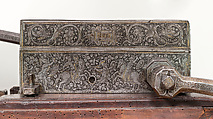Returned to lender The Met accepts temporary loans of art both for short-term exhibitions and for long-term display in its galleries.
Wire Drawing Bench of the Saxon Electors
Leonhard Danner German
Not on view
Video
The bench is designed for the production of thin wire from gold, silver, and other metals. The end product was used in the decoration of weapons, furniture, and vessels, and for weaving and embroidery. Threaded through a draw plate, the metal was pulled with pincers and wound around a drawing winch to be cranked along the bench. The process was repeated through successively smaller holes in the draw plates to obtain the desired diameter. Goldsmiths had used tools of this type since the late Middle Ages, but this unusually large example would have outperformed the smaller models in most workshops. With it, a skilled artisan could also cut screws, springs, and fine moldings. It is unclear whether Augustus used the bench himself, but he and his guests would have appreciated its state-of-the-art design.
A Prince Practitioner
Augustus, Elector of Saxony, commissioned this innovative device from the Nuremberg artist-engineer, cabinetmaker, and screw maker Leonhard Danner. Affectionately nicknamed "Father Augustus" and "Mother Anna" by their people, the ruler and his wife both sought out activities in agriculture, alchemy, and medicine that might help to improve the Saxon economy. The Kunstkammer Augustus assembled in Dresden reflects these interests: at the time of his death nearly 80 percent of its holdings were related to the arts and sciences.
Marvelous Marquetry
The size of the bench made it a perfect canvas for an extravagant program of marquetry, or decorative inlaid wood, designed by an unknown artist with the initials "A.M." to appeal to Augustus’s tastes. In addition to his practical work, the elector crafted his public image by staging elaborate tournaments. The long sides of the bench feature tournament scenes, while each end features his coat of arms. The inclusion of disparaging caricatures of Catholics reflects Augustus’s status as a strict adherent of the newly established Protestant faith.
The Bench and Its Parts
Augustus had the bench and its accompanying tools installed in his Dresden Kunstkammer in 1566. While the piece and most of its accessories are now in the collection of the Musée National de la Renaissance in Écouen, France, its drawing winch, wire roll, and a lifting jack also by Danner remained in Dresden. The engraved drawing winch and the wire roll are part of the bench’s mechanism. The various parts are reunited here for the first time in North America.
Due to rights restrictions, this image cannot be enlarged, viewed at full screen, or downloaded.
This artwork is meant to be viewed from right to left. Scroll left to view more.




